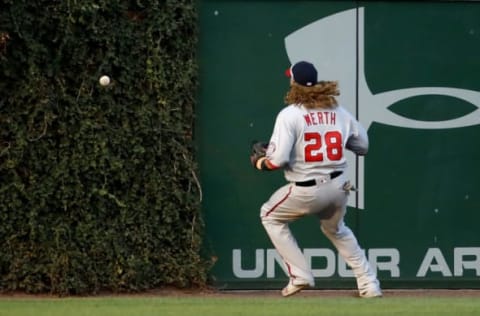Atlanta Braves take full advantage of everything Jayson Werth is complaining about


As a fellow ‘get off my lawn’ guy, I can understand Jayson Werth’s rant. But sometimes you do actually have to lay some new sod on that lawn.
The Atlanta Braves are doing a lot of new work with advanced baseball metrics – even ramping up previous efforts that were underway prior to the arrival of Alex Anthopoulos. But to hear former rival Jayson Werth talk about such things, he believes that the sport of baseball is being ruined by such things.
In a wide-ranging interview held via the Howard Eskin Podcast (radio 94 WIP in Philadelphia), Werth talked about his attempts to play again this season and about some of the complaints he has about the current state of the game, which dovetailed off of a conversation about new hyper-Sabremetrically-inclined Philly manager Gabe Kapler.
Here (transcribed) are some of his key statements from the interview linked above:
“I think it’s killing the game… It’s to the point where – just put computers out there…and let ’em play. – we don’t even need to go out there anymore. It’s a joke.” “It’s crazy… when they come down – these kids… from M.I.T. or Stanford or Harvard… wherever they’re from… never played baseball in their life… the question [from Howard] was asked about the shift, well should I just bunt it over there [toward the hole]? They’re like ‘no, don’t do that – we don’t want you to do that – we want you to hit a homer’… It’s just not baseball.” “We’re creating something that’s not fun to watch; it’s boring, it’s… we’re turning players into robots; they’ve taken the human element out of the game… I’m not a big fan of the instant replay…more rule changes in the past 5 years than in the first 120 combined.” “It’s worrisome – It’s a beautiful game and I think it’s getting screwed up.”
This requires some discussion.

The Origin of Stats
In the years before computers, all we had – as fans and as participants in the game – were our eyes. Managers made changes based on their experiences and based on their instincts. We called such actions ‘gut feelings’ and the like. In those days, the only things we’d see published in The Sporting News or our local newspaper were things like AB, HR, RBI, AVG… that was about it.
The best managers had their gut moves pay off more often than not. But think about how this would be the case: it’s because they had – in their heads – some kind of a metric… a trend, a scouting report, a matchup… that they believed would work. All of these things came from observation and experience.
Moving forward, think about the “4D Chess” matches that Greg Maddux was said to have played with over-matched hitters. He would make pitches in situations that he knew hitters would not expect because he would set them up months ahead of time.
How so? Mad Dog learned this by probing good hitters. Witness this:
Good hitters, such as Pendleton or Chipper Jones, became a resource. Maddux wanted to know what they thought in certain scenarios. “He’d ask … if you know his best pitch is his change-up, are you going to [wait] on that change-up the whole at-bat?” Pendleton said. “I said, ‘I know you’ll throw your change-up with two strikes.’ He said ‘OK, good. If I throw it to the right place, you’re still not going to hit it.’”
On the flip side, Chipper Jones was said to be about scrutinizing pitchers for weaknesses. Tony Gwynn was the a pioneer and a King of the video room. So what are these things aside from the proper application of a hyper-advanced metric?
The finds you discover in antique shops! The Bill James books are each $1. pic.twitter.com/GJs6QXhyhs
— KS_Southpaw_™ (@BravesFan_Dan) August 11, 2018
These things are all the result of observation, investigation, and application… but they are born of human activity while sabremetrics represent a means of attempting to do the same with a computer.

So what are advanced stats?
I am a software engineer by trade. What I do is actually not unlike what the sabrematricians do: attempting to take the available data and developing tools to recognize patterns.
Take facial recognition software as an example. You or I can look at two different photos and usually decide instantly whether they are images of the same person.
To simulate such behavior, computers must be taught to do what we intuitively do via our minds and our sight… and that’s a difficult task. Programmers must come up with a variety of tools – control points, stats, etc. – to be able to mimic our innate ability.
But it’s an imperfect science. I am reminded of Helen Hunt’s line in the movie Twister about state of the art in tornado warnings: “They’re not good enough, they’re nowhere near good enough.” The same thing applies here, too.
The holy grail of this new science would be to guess what any hitter’s outcome is going to be for any given plate appearance, pitcher, pitcher’s repertoire, location, weather, trends, etc.
Now granted: this goal will never be achieved. But you can make better educated guesses about such things… and here’s a bulletin: managers have been using such tools for longer than you might believe.
This actually isn’t all together new
Are you old enough to see a camera panned into a dugout while a manager and his bench coach are flipping pages in a notebook? You think that’s only a list of players that he still has on the bench to use? Nope… such “charts” as they were called were trends of player performance vs. pitchers – done in an era before computers made it much easier to store, manage, and retrieve such information.
You recall when pitchers ‘charted pitches’ before an upcoming start? You think that data was just thrown in the trash afterwards?
No – it’s all data: every bit of it. From Strat-O-Matic baseball cards to Bill James to modern stats… you can draw a straight line from ‘old school’ baseball to today because every team has always wanted an edge to gain an advantage over their competition.

Change
Let me run down a list of some things that have occurred or otherwise been introduced over the past several decades that somebody-or-another thought would destroy baseball:
- expansion
- inter-league play
- the designated hitter (okay, yeah, I’m still bitter about this one)
- lowering the mound
- the 162-game schedule
- free agency
- work-stoppages
- the 5-man rotation
- the era of specialization (relief pitchers)
- steroids
- lights at Wrigley Field (okay – only in Chicago did they think so)
- small ballparks
- instant replay (the jury might still be out on this one) and manager challenges
- the Wild Card playoff system
- the “Buster Posey rule” on slides
- the ‘wave off’ intentional walk
- the pitch clock and mound visit limitations
That’s just the ones off the top of my head. There have been changes in equipment (bats, gloves, and balls), changes in umpires (no longer league-separated), changes on the field (the1st base running lane, the ‘batter’s eye’, and changes in uniforms (seemingly on a weekly basis now).
Here’s a snippet from Hall of Famer Bob Gibson about the mound height change in 1968, conducted 40 years after his stunning season (1.12 ERA):
“Why should they take away the pitcher’s livelihood because he becomes proficient at it?” Gibson asks. “That, to me, seems like what they did. The hitters weren’t doing very well against you so they say ‘Well, we’re going to fix that.’ “I still might sue baseball for that.” … The mound had a 15-inch elevation in 1968, and in 1969 it was only 10 inches, a huge change akin to expanding the nets in hockey.
In short, there hasn’t been any aspect of the game that hasn’t seen some form of change over the years and more changes are still coming – I, for one, am an advocate of the rodo-ump concept for balls and strikes.
The game is different but it’s been getting different for… decades.

Where Werth might be right
Now Jayson Werth was engaging in a bit of hyperbole in that interview, but it was also borne out of the frustration you could hear in his voice about how the past off-season came around for him… which effectively resulted in a ‘semi-forced’ retirement that he hasn’t been willing to embrace.
I get that – I feel for him, for nobody wants to be told that there isn’t a place for him any longer. That’s a a rough thing.
But in that interview was the suggestion of how I believe advanced stats get misused in some circles. Let me explain.
Werth so much as declared that in a shift situation, players are being told to ignore the fact that there’s a massive hole on one side of the infield and that they should aim for the fences – essentially all the time.
This is the same mentality that has created the current New York Yankees: get enough bombers in your lineup and just swing away: get 3 or 4 homers a game and we don’t care if you guys strike out 18 times in a 27-out game. That’s over-simplified, but it’s also not far off.
The Yankees are leading baseball with 188 homers… in 115 games. Even though the formula is off, it’s still mostly working for them (they would be leading every other division in baseball, save for the AL West).
The Flip Side
Yet you have other teams – like the Atlanta Braves – who seem to be taking a more strategic (overarching) view of using advanced stats… and one that favors their players’ style:
- More running
- More 1st pitch strikes (Sean Newcomb and Kevin Gausman have both benefited greatly here)
- Better positioning in the field (Nick Markakis)
- Better defense in general
Gausman spoke of this just last night after one of his best performances of the year.
In short (I know – too late for that), here’s my overall philosophy on baseball advanced metrics:
- They are not perfect
- They need not be forced into use
- Common sense and skill must still prevail (i.e., if a team is giving you the entire left side of the infield, then take it)
- They can be misused (i.e., my common complaints about BABIP and luck or FIP ignoring 2/3rds of the game)
- They can be helpful to establish trends
This whole statistical “industry” that we bloggers use, that teams use, that baseball sites use… this is not going away. These things can be used to improve how the game is played if used correctly.
Trending
More from Tomahawk Take
- Atlanta Braves 2012 Prospect Review: Joey Terdoslavich
- Braves News: Braves sign Fuentes, Andruw’s HOF candidacy, more
- The Weakest Braves Homers Since 2015
- Atlanta Braves Sign Joshua Fuentes to Minor League Deal
- Braves News: New Year’s Eve comes with several questions about the 2023 Braves
The pendulum has swung wildly, perhaps, in a new direction… time will tell if it swings further or swings back a bit.
Likewise, teams will have to evaluate themselves to learn if their own methods for using advanced stats are actually helpful or harmful… essentially having to use stats on themselves to make such a determination.
Adjustments will be made as part of the process and that’s how change happens in life.
I’m not going to blame Werth for his rant – in his position I likely would do so, too. But I also don’t believe this new wave of data will kill baseball.
In fact, from this writer’s observations, our Braves are doing it right.

Werth’s Last Stand
Werth, who is now 39, still believed early this year that he had something more to give that teams could use, and told Eskin that after having been advised by his “former” agent (Scott Boras) to “wait” on offers made early in the off-season, he finally decided to “take matters into [his] own hands”.
With some evident disappointment in his voice about the process he was forced to go through – and this is why he fired Boras – he personally called every team to see if he could get an opportunity to play in 2018.
Provided by Baseball-Reference.com: View Original Table
Werth talked to nearly every GM, finally getting a AAA chance with Seattle, but hamstring injuries, timing, and more conspired to leave him home and retired by mid-June. It was kind of sad to listen to this.
Well… there was one team he didn’t call when he was beating the bushes in looking for work… one team that he said he would not play for.
Next. Could this be the Braves' off-season direction?. dark
The Mets.